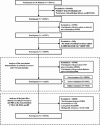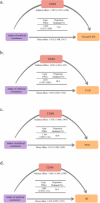Artificial sweeteners and risk of incident cardiovascular disease and mortality: evidence from UK Biobank
- PMID: 38965574
- PMCID: PMC11225337
- DOI: 10.1186/s12933-024-02333-9
Artificial sweeteners and risk of incident cardiovascular disease and mortality: evidence from UK Biobank
Abstract
Background: Artificial sweeteners are widely popular worldwide as substitutes for sugar or caloric sweeteners, but there are still several important unknowns and controversies regarding their associations with cardiovascular disease (CVD). We aimed to extensively assess the association and subgroup variability between artificial sweeteners and CVD and CVD mortality in the UK Biobank cohort, and further investigate the modification effects of genetic susceptibility and the mediation role of type 2 diabetes mellitus (T2DM).
Methods: This study included 133,285 participants in the UK Biobank who were free of CVD and diabetes at recruitment. Artificial sweetener intake was obtained from repeated 24-hour diet recalls. Cox proportional hazard models were used to estimate HRs. Genetic predisposition was estimated using the polygenic risk score (PRS). Furthermore, time-dependent mediation was performed.
Results: In our study, artificial sweetener intake (each teaspoon increase) was significantly associated with an increased risk of incident overall CVD (HR1.012, 95%CI: 1.008,1.017), coronary artery disease (CAD) (HR: 1.018, 95%CI: 1.001,1.035), peripheral arterial disease (PAD) (HR: 1.035, 95%CI: 1.010,1.061), and marginally significantly associated with heart failure (HF) risk (HR: 1.018, 95%CI: 0.999,1.038). In stratified analyses, non-whites were at greater risk of incident overall CVD from artificial sweetener. People with no obesity (BMI < 30 kg/m2) also tended to be at greater risk of incident CVD from artificial sweetener, although the obesity interaction is not significant. Meanwhile, the CVD risk associated with artificial sweeteners is independent of genetic susceptibility, and no significant interaction exists between genetic susceptibility and artificial sweeteners in terms of either additive or multiplicative effects. Furthermore, our study revealed that the relationship between artificial sweetener intake and overall CVD is significantly mediated, in large part, by prior T2DM (proportion of indirect effect: 70.0%). In specific CVD subtypes (CAD, PAD, and HF), the proportion of indirect effects ranges from 68.2 to 79.9%.
Conclusions: Our findings suggest significant or marginally significant associations between artificial sweeteners and CVD and its subtypes (CAD, PAD, and HF). The associations are independent of genetic predisposition and are mediated primarily by T2DM. Therefore, the large-scale application of artificial sweeteners should be prudent, and the responses of individuals with different characteristics to artificial sweeteners should be better characterized to guide consumers' artificial sweeteners consumption behavior.
© 2024. The Author(s).
Conflict of interest statement
The authors declare no competing interests.
Figures


Similar articles
-
Joint and interactive associations of body mass index and genetic factors with cardiovascular disease: a prospective study in UK Biobank.BMC Public Health. 2024 Sep 2;24(1):2371. doi: 10.1186/s12889-024-19916-6. BMC Public Health. 2024. PMID: 39223569 Free PMC article.
-
Adherence to a planetary health diet, genetic susceptibility, and incident cardiovascular disease: a prospective cohort study from the UK Biobank.Am J Clin Nutr. 2024 Sep;120(3):648-655. doi: 10.1016/j.ajcnut.2024.06.014. Epub 2024 Jun 29. Am J Clin Nutr. 2024. PMID: 38950778
-
Association of oxidative balance score with incident cardiovascular disease in patients with type 2 diabetes: findings of the UK Biobank study.Eur J Nutr. 2025 Mar 6;64(3):110. doi: 10.1007/s00394-024-03552-2. Eur J Nutr. 2025. PMID: 40047957
-
Association of BMI with cardiovascular disease incidence and mortality in patients with type 2 diabetes mellitus: A systematic review and dose-response meta-analysis of cohort studies.Nutr Metab Cardiovasc Dis. 2021 Jun 30;31(7):1976-1984. doi: 10.1016/j.numecd.2021.03.003. Epub 2021 Mar 19. Nutr Metab Cardiovasc Dis. 2021. PMID: 33965298
-
Non-nutritive sweeteners for diabetes mellitus.Cochrane Database Syst Rev. 2020 May 25;5(5):CD012885. doi: 10.1002/14651858.CD012885.pub2. Cochrane Database Syst Rev. 2020. PMID: 32449201 Free PMC article.
Cited by
-
Cardiovascular health and cancer mortality: evidence from US NHANES and UK Biobank cohort studies.BMC Med. 2024 Sep 5;22(1):368. doi: 10.1186/s12916-024-03553-2. BMC Med. 2024. PMID: 39237921 Free PMC article.
-
Aspartame and ischemic stroke: unraveling the molecular link through network toxicology and molecular docking analysis.Sci Rep. 2025 Jul 4;15(1):23871. doi: 10.1038/s41598-025-08898-z. Sci Rep. 2025. PMID: 40615604 Free PMC article.
-
Overnutrition in the Elderly Population: Socio-Demographic and Behavioral Risk Factors in Hungary.Nutrients. 2025 Jun 8;17(12):1954. doi: 10.3390/nu17121954. Nutrients. 2025. PMID: 40573065 Free PMC article.
-
Artificial Sweeteners and Cardiovascular Risk in Hungary: Beyond Traditional Risk Factors.J Clin Med. 2025 Jun 30;14(13):4641. doi: 10.3390/jcm14134641. J Clin Med. 2025. PMID: 40649013 Free PMC article.
-
Lifestyle, nutritional, and health influences on consumption of artificially-sweetened beverages in educated urban populations.PLoS One. 2025 Apr 29;20(4):e0322553. doi: 10.1371/journal.pone.0322553. eCollection 2025. PLoS One. 2025. PMID: 40299824 Free PMC article.
References
Publication types
MeSH terms
Substances
Grants and funding
LinkOut - more resources
Full Text Sources
Medical
Research Materials
Miscellaneous

